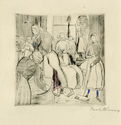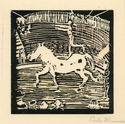
19th, 20th & 21st Century Fine Prints
707-546-7352 · fax 707-546-7924 · web: www.annexgalleries.com · email: artannex@aol.com
Paula Wimmer Biography
Paula Wimmer
German
1876–1971
Biography
Paula Wimmer, was born in 1876 in Solln, Munich Germany on January 9. After visiting the girls' high school, where she displayed talent for drawing and painting, she decided on an artistic education. She first studied with Carl Johann Becker-Gundahl at the Academy of Fine Arts, Munich. There she met artists Franz von Stuck and Max Feldbauer. She continued her studies in Florence, Italy at the Academia, then in Paris at the École Rancon and 1908 at the private art school of Max Bauer Field in Dachau and Munich, where she learned the Aktzeichnens style of plein air painting she became dedicated to. She accompanied Max Feldbauer to Griesbach / Lower Bavaria and also accompanied him on a study trip to Brittany. When her teacher was called to Dresden, Wimmer returned to Dachau, Germany. She broke away from the impressionist style of Max Bauer and explored the independent artistic expression of Expressionism. Even as a student Paula Wimmer was made a member of the Academy of Fine Arts, Munich.
Wimmer also undertook study trips to Venice, Florence, Rome and Paris. In 1914 she went with her mother to Berlin, where she lived for two years and associated with leading representatives of Expressionism, who influenced her profoundly. In the well-known art critic Paul Westheim, who campaigned particularly for those avant-garde, Paula Wimmer found an influential patron. In Berlin Paula Wimmer became a friend of the German-Jewish poet Else Lasker-Schüler.
After 1916, she made Dachau her permanent home. There she attended the private painting school of Adolf Hölzel (1853-1934), who always came in the summer months with a large group of disciples from Stuttgart to Dachau, and was a close friends with Ida Kerkovius (1879-1970), Maria Langer-Scholler (1878-1969) and Else von Freytag-Lovinghoven (1874-1927), to name just a few. to the so-called. "Malweibern" (Women of the Times).
Paula Wimmer also worked as a Fresco painter in Dachau’s "St. Jacob's Church." In Dachau the painter and graphic artist was a member of the "group of Dachau Artists", the "Dachau Art Association" and the" New Secession.” With great success she charged into the 1920s and 1930s, holding exhibitions in Munich, Rome, Vienna, Berlin, Paris, Stuttgart, Salzburg, etc. In 1918 in Salzburg she was awarded the "Silver State Medal." Paula Wimmer's success resulted in the Nazis rating her works as “degenerate art” and destroyed many of them. After that she began to work in a naive style and paint with innocuous picture themes.
After World War II, her works were represented at the exhibition in the Haus der Kunst, Munich. She ranks formost among the Dachau Artist group. In her adopted home there is a street called the "Paula-Wimmer-Stube". Many of her works can be seen in the "Gemäldegalerie Dachau".
Paula Wimmer died on June 15, 1971 in Dachau, Germany.


